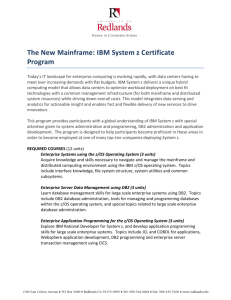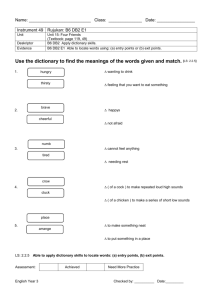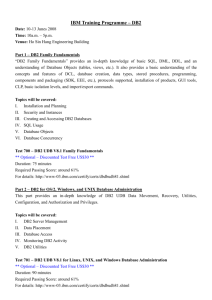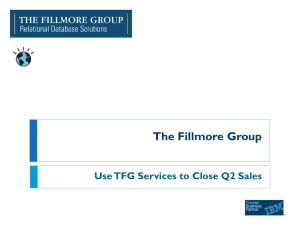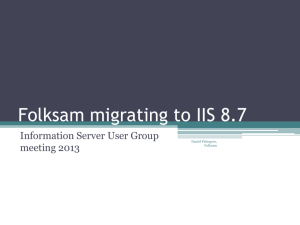Download PDF (1.5 MB)
advertisement
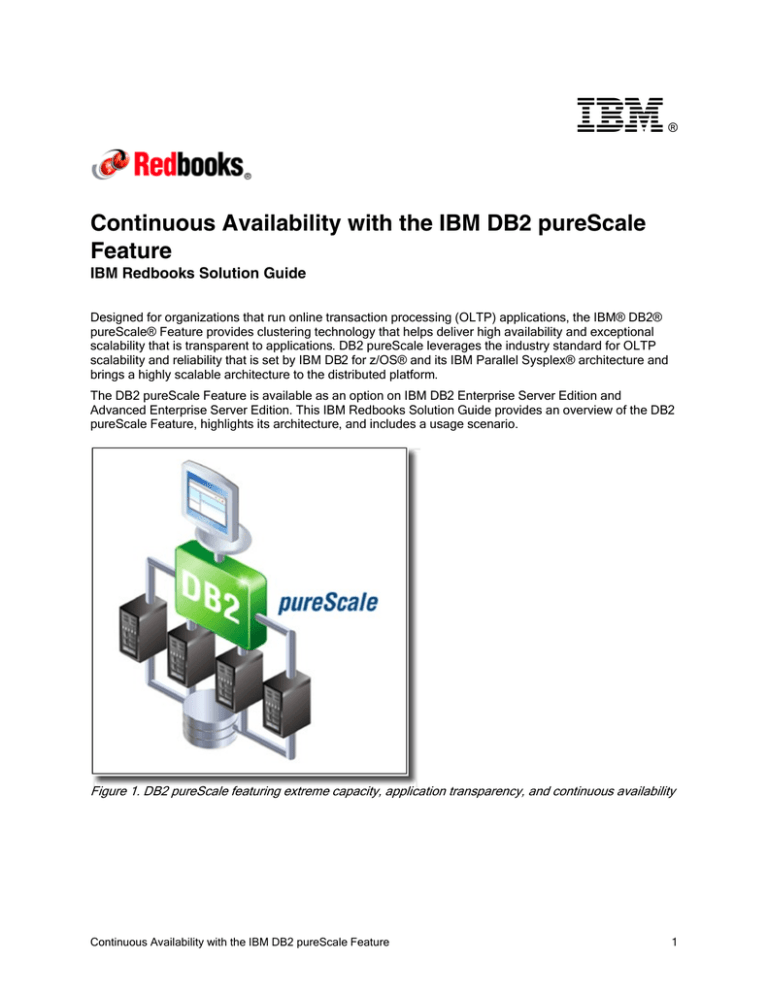
® Continuous Availability with the IBM DB2 pureScale Feature IBM Redbooks Solution Guide Designed for organizations that run online transaction processing (OLTP) applications, the IBM® DB2® pureScale® Feature provides clustering technology that helps deliver high availability and exceptional scalability that is transparent to applications. DB2 pureScale leverages the industry standard for OLTP scalability and reliability that is set by IBM DB2 for z/OS® and its IBM Parallel Sysplex® architecture and brings a highly scalable architecture to the distributed platform. The DB2 pureScale Feature is available as an option on IBM DB2 Enterprise Server Edition and Advanced Enterprise Server Edition. This IBM Redbooks Solution Guide provides an overview of the DB2 pureScale Feature, highlights its architecture, and includes a usage scenario. Figure 1. DB2 pureScale featuring extreme capacity, application transparency, and continuous availability Continuous Availability with the IBM DB2 pureScale Feature 1 Did you know? DB2 pureScale is more than just a feature. It is a whole new way to look at DB2 databases. You are no longer limited to a single host to access your data, and you are not required to partition your data so that each host owns a partition. DB2 pureScale provides a clustered solution that uses multiple hosts to access the same data partition, allowing for increased capacity and continuous availability. Business value Does your database cluster give you headaches? Is it cumbersome to add a node to your cluster? When you lose a node, does your cluster freeze? Is it difficult to tune your system for optimal performance? If your answer to any of these questions is yes, simplify your environment with the scalable database cluster capability of the IBM DB2 pureScale Feature. DB2 pureScale delivers unmatched levels of database scalability and availability on UNIX or Linux systems, and maintains application transparency: Grow with your business. By using DB2 pureScale, your database can continue processing through unplanned outages and take advantage of extreme capacity for any transactional workload. Scaling your system is a matter of connecting a host and issuing two simple commands. With DB2 pureScale, you can scale your OLTP systems to meet the most demanding business needs and control data management costs. Scale up transparently without complex application tuning. As application usage grows, the databases must grow in step with application usage to ensure that the business continues operating smoothly and without bottlenecks. DB2 pureScale does not require administrators to perform complex tuning or update application code when scaling the database. The flexible application workload balancing and grouping capabilities of DB2 pureScale allow multiple servers to appear as a single database, and new hosts can be used immediately. This feature helps to reduce deployment complexity and to cut costs. Maintain continuous availability. Just a few minutes of downtime for critical applications can significantly damage an organization’s bottom line. DB2 pureScale continues operating even if host failure occurs, and it maintains data consistency without performance degradation. Centralized locking and cache management allow the remaining hosts in the cluster to access critical information promptly and quickly absorb the additional workload. No incoming workloads are rejected because the cluster can automatically adjust within seconds. During planned outages, administrators can perform rolling maintenance on individual hosts without affecting the availability of the cluster. Support performance with a clustering architecture that is designed for scalability. Designed for high-use clustered servers, the DB2 pureScale architecture helps ensure that applications do not hit a scalability wall after the workload is distributed across more than a few hosts. It can deliver near-linear scalability and maximum throughput, helping to reduce software licensing costs and power and cooling expenditures. Simplify database management with streamlined installation and monitoring. DB2 pureScale simplifies database and clustering administration. Hosts can be added to and removed from the cluster easily so that IT staff can scale the cluster up or down quickly to meet changing business requirements. DB2 pureScale also features a single installation process for all software components. One bundle contains all the tools that are necessary for setup, which is automated at installation. Continuous Availability with the IBM DB2 pureScale Feature 2 Take advantage of smooth scaling, which is key to an outstanding customer experience. The ability to grow transactional databases with customer demand is imperative for companies that are trying to capitalize on new business opportunities. DB2 pureScale can help deliver this scalability and lower costs through extreme capacity, application transparency, and continuous availability. Solution overview With an increasing focus on 24x7 availability, companies must be prepared to handle both planned (maintenance) and unplanned outages. In regard to continuous availability, the DB2 pureScale Feature is enhanced to better reflect its capabilities as a clustered database solution (Figure 2). Figure 2. DB2 pureScale architecture The DB2 pureScale Feature was first introduced in DB2 9.8, which was a DB2 pureScale-only release. DB2 10 builds on DB2 pureScale Feature support, reliability, and performance. In DB2 10, the DB2 pureScale Feature is included in certain DB2 editions and can be installed as a native component. Improvements to supported networks and various performance improvements save database administrators time and resources. DB2 pureScale is available as an option on IBM DB2 Enterprise Server Edition and Advanced Enterprise Server Edition. You can use the IBM DB2 pureScale Feature to scale a database for a set of servers in an active-active approach. Traffic that is intended for a failed node is passed on to an existing node or is load balanced for Continuous Availability with the IBM DB2 pureScale Feature 3 the remaining nodes. This DB2 pureScale technology is based on the proven DB2 for IBM z/OS Parallel Sysplex architecture that is recognized as a gold industry standard for maintaining high availability and scalability. The DB2 pureScale system runs on up to 128 multiple hosts that access shared data simultaneously, without a need to explicitly modify the application. You can use this transparency to perform maintenance operations on hosts, add more hosts, or remove unnecessary hosts, without affecting an application. By using this method, you can control the number of active hosts to handle the workload and to ensure that you remain at the wanted transaction rate. Solution architecture A DB2 pureScale instance consists of members and the cluster caching facility (CF) servers. A typical DB2 pureScale environment has four members and two CFs: a primary CF and a secondary CF (Figure 3). Figure 3. A DB2 pureScale cluster with four members and two cluster caching facilities Continuous Availability with the IBM DB2 pureScale Feature 4 DB2 cluster services is a set of subcomponents and services that provide built-in failure detection, recovery automation, and a cluster file system for shared access. The cluster services include other industry-leading IBM software: IBM General Parallel File System (IBM GPFS™) Reliable Scalable Cluster Technology (RSCT) IBM Tivoli® Systems Automation for Multiplatforms Each member and CF have a cluster service. The cluster service constantly monitors the members and CFs, and it automatically initiates recovery processing if required. The cluster service monitors several resources, including the following examples: Access to paths and file systems Cluster caching facility server processes DB2 processes Host computers in the cluster Network adapters Usage scenario Running Linux on IBM System x® servers provides clients with a cost-effective, reliable, and secure IT environment that can scale with mission-critical workload demands. With DB2 pureScale running on System x, IBM achieved the first clustered database result that was published for the SAP Transaction Banking standard application benchmark in September 2011. The system processed more than 56 million posting transactions per hour and more than 22 million balanced accounts per hour while simultaneously supporting banking industry system availability requirements (Figure 4). Figure 4. DB2 pureScale postings and accounts processed per hour for SAP Transaction Banking Continuous Availability with the IBM DB2 pureScale Feature 5 Integration and supported platforms A DB2 pureScale cluster consists of various hardware components, including the servers, networking, and storage (Figure 5). Building the DB2 pureScale cluster involves different hardware components, including the servers, storage subsystem, and switches. IBM offers efficient and highly reliable scaling capability across the following leading business computing platforms: IBM Power Systems™ IBM System x Plus Running on these platforms, DB2 pureScale provides reliability and virtualization features, in addition to cost-effective choices. Figure 5. DB2 pureScale Feature support of various hardware and software For more information about the supported hardware and software, see the "Planning for an IBM DB2 pureScale Feature for Enterprise Server Edition deployment" topic in the DB2 Information Center at: http://pic.dhe.ibm.com/infocenter/db2luw/v9r8/topic/com.ibm.db2.luw.sd.doc/doc/c0056281.html Continuous Availability with the IBM DB2 pureScale Feature 6 Ordering information DB2 pureScale is a separately priced feature available in several DB2 product editions: DB2 Enterprise Server Edition http://www.ibm.com/software/data/db2/linux-unix-windows/edition-enterprise.html DB2 Advanced Enterprise Server Edition http://www.ibm.com/software/data/db2/linux-unix-windows/edition-advanced-enterprise.html Related information For more information, see the following documents: IBM DB2 Enterprise Server Edition V10.1 Sales Manual http://ibm.co/SeBtS2 Unleashing DB2 10 for Linux, UNIX, and Windows, SG24-8032 http://www.redbooks.ibm.com/abstracts/sg248032.html Highly Available and Scalable Systems with IBM eX5 and DB2 pureScale, REDP-4742 http://www.redbooks.ibm.com/abstracts/redp4742.html?Open "Introduction to the IBM DB2 pureScale Feature" http://bit.ly/R9vP4o DB2 pureScale: Risk Free Agile Scaling, ISBN 978-0-07-175240-4 http://public.dhe.ibm.com/common/ssi/ecm/en/imm14079usen/IMM14079USEN.PDF Continuous Availability with the IBM DB2 pureScale Feature 7 Notices This information was developed for products and services offered in the U.S.A. IBM may not offer the products, services, or features discussed in this document in other countries. Consult your local IBM representative for information on the products and services currently available in your area. Any reference to an IBM product, program, or service is not intended to state or imply that only that IBM product, program, or service may be used. Any functionally equivalent product, program, or service that does not infringe any IBM intellectual property right may be used instead. However, it is the user's responsibility to evaluate and verify the operation of any non-IBM product, program, or service. IBM may have patents or pending patent applications covering subject matter described in this document. The furnishing of this document does not give you any license to these patents. You can send license inquiries, in writing, to: IBM Director of Licensing, IBM Corporation, North Castle Drive, Armonk, NY 10504-1785 U.S.A. The following paragraph does not apply to the United Kingdom or any other country where such provisions are inconsistent with local law: INTERNATIONAL BUSINESS MACHINES CORPORATION PROVIDES THIS PUBLICATION "AS IS" WITHOUT WARRANTY OF ANY KIND, EITHER EXPRESS OR IMPLIED, INCLUDING, BUT NOT LIMITED TO, THE IMPLIED WARRANTIES OF NON-INFRINGEMENT, MERCHANTABILITY OR FITNESS FOR A PARTICULAR PURPOSE. Some states do not allow disclaimer of express or implied warranties in certain transactions, therefore, this statement may not apply to you. This information could include technical inaccuracies or typographical errors. Changes are periodically made to the information herein; these changes will be incorporated in new editions of the publication. IBM may make improvements and/or changes in the product(s) and/or the program(s) described in this publication at any time without notice. Any references in this information to non-IBM Web sites are provided for convenience only and do not in any manner serve as an endorsement of those Web sites. The materials at those Web sites are not part of the materials for this IBM product and use of those Web sites is at your own risk.IBM may use or distribute any of the information you supply in any way it believes appropriate without incurring any obligation to you. Information concerning non-IBM products was obtained from the suppliers of those products, their published announcements or other publicly available sources. IBM has not tested those products and cannot confirm the accuracy of performance, compatibility or any other claims related to non-IBM products. Questions on the capabilities of non-IBM products should be addressed to the suppliers of those products. This information contains examples of data and reports used in daily business operations. To illustrate them as completely as possible, the examples include the names of individuals, companies, brands, and products. All of these names are fictitious and any similarity to the names and addresses used by an actual business enterprise is entirely coincidental. Any performance data contained herein was determined in a controlled environment. Therefore, the results obtained in other operating environments may vary significantly. Some measurements may have been made on development-level systems and there is no guarantee that these measurements will be the same on generally available systems. Furthermore, some measurement may have been estimated through extrapolation. Actual results may vary. Users of this document should verify the applicable data for their specific environment. COPYRIGHT LICENSE: This information contains sample application programs in source language, which illustrate programming techniques on various operating platforms. You may copy, modify, and distribute these sample programs in any form without payment to IBM, for the purposes of developing, using, marketing or distributing application programs conforming to the application programming interface for the operating platform for which the sample programs are written. These examples have not been thoroughly tested under all conditions. IBM, therefore, cannot guarantee or imply reliability, serviceability, or function of these programs. © Copyright International Business Machines Corporation 2012. All rights reserved. Note to U.S. Government Users Restricted Rights -- Use, duplication or disclosure restricted by GSA ADP Schedule Contract with IBM Corp. Continuous Availability with the IBM DB2 pureScale Feature 8 This document was created or updated on October 31, 2012. Send us your comments in one of the following ways: Use the online Contact us review form found at: ibm.com/redbooks Send your comments in an e-mail to: redbook@us.ibm.com Mail your comments to: IBM Corporation, International Technical Support Organization Dept. HYTD Mail Station P099 2455 South Road Poughkeepsie, NY 12601-5400 U.S.A. This document is available online at http://www.ibm.com/redbooks/abstracts/tips0926.html . Trademarks IBM, the IBM logo, and ibm.com are trademarks or registered trademarks of International Business Machines Corporation in the United States, other countries, or both. These and other IBM trademarked terms are marked on their first occurrence in this information with the appropriate symbol (® or ™), indicating US registered or common law trademarks owned by IBM at the time this information was published. Such trademarks may also be registered or common law trademarks in other countries. A current list of IBM trademarks is available on the Web at www.ibm.com/legal/copytrade.shtml The following terms are trademarks of the International Business Machines Corporation in the United States, other countries, or both: DB2® GPFS™ IBM® Parallel Sysplex® Power Systems™ pureScale® Redbooks® Redbooks (logo)® System x® Tivoli® z/OS® The following terms are trademarks of other companies: Linux is a trademark of Linus Torvalds in the United States, other countries, or both. Windows, and the Windows logo are trademarks of Microsoft Corporation in the United States, other countries, or both. UNIX is a registered trademark of The Open Group in the United States and other countries. Other company, product, or service names may be trademarks or service marks of others Continuous Availability with the IBM DB2 pureScale Feature 9
